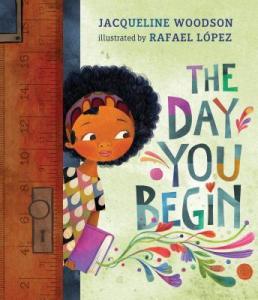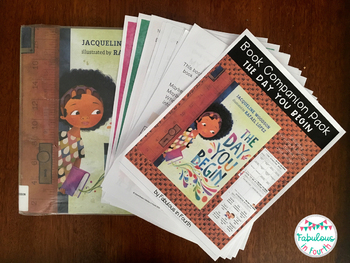

I chalked stories across sidewalks and penciled tiny tales in notebook margins. (It was not pretty for me when my mother found out.) I wrote on paper bags and my shoes and denim binders. I remember my uncle catching me writing my name in graffiti on the side of a building. You can find a full set of discussion cards in The Day You Begin Literacy Bundle or as a separate pack.I used to say I’d be a teacher or a lawyer or a hairdresser when I grew up but even as I said these things, I knew what made me happiest was writing. Why do you think Jacqueline Woodson and Rafael López added so many rulers to the illustrations?.What were the differences between the students in The Day You Begin? Can you make any connections to them?.

How can you help some ‘begin’ when they are new to our school/classroom?.
 Have you ever been in a room of people who differ from you? How did it make you feel?. How do the author and illustrator show the character’s emotions throughout the book?. Why do you think the characters felt the way they did?. What did you learn from reading The Day You Begin?. Now you have finished the book, why do you think the book is called The Day You Begin?. What do you think Jacqueline Woodson wants us to learn from reading The Day You Begin?. You can also introduce different genres, authors and illustrators. You can model reading habits and strategies, reading fluency, tone and eye contact. Read aloud sessions are a wonderful way for children to understand the connection between written text and spoken language. Rafael López incorporates rulers into the illustrations as a metaphor for measuring ourselves against others. Our race, cultural traditions, the way we look, what we eat are not a barrier to making connections with others, but only increase open-mindedness, appreciation and positive friendships. The story shows our stories help us make connections to other people and realize our special and unique differences. The day we share our stories is the day we begin. Woodson reminds us we are all outsiders, and it takes courage to be ourselves. Woodson highlights we are all different, whether this is our accent so “no one understands the way words curl from your mouth.” Or the food we eat that is “too strange or too unfamiliar for others to love as you do.” We learn about one student who feels self-conscious that she stayed on her block during the summer while her classmates traveled the world. “There will be times when you walk into a room and no one there is quite like you until the day you begin to share your stories.” The Day You Being celebrates diversity in the classroom and how we can learn about the world from each other.
Have you ever been in a room of people who differ from you? How did it make you feel?. How do the author and illustrator show the character’s emotions throughout the book?. Why do you think the characters felt the way they did?. What did you learn from reading The Day You Begin?. Now you have finished the book, why do you think the book is called The Day You Begin?. What do you think Jacqueline Woodson wants us to learn from reading The Day You Begin?. You can also introduce different genres, authors and illustrators. You can model reading habits and strategies, reading fluency, tone and eye contact. Read aloud sessions are a wonderful way for children to understand the connection between written text and spoken language. Rafael López incorporates rulers into the illustrations as a metaphor for measuring ourselves against others. Our race, cultural traditions, the way we look, what we eat are not a barrier to making connections with others, but only increase open-mindedness, appreciation and positive friendships. The story shows our stories help us make connections to other people and realize our special and unique differences. The day we share our stories is the day we begin. Woodson reminds us we are all outsiders, and it takes courage to be ourselves. Woodson highlights we are all different, whether this is our accent so “no one understands the way words curl from your mouth.” Or the food we eat that is “too strange or too unfamiliar for others to love as you do.” We learn about one student who feels self-conscious that she stayed on her block during the summer while her classmates traveled the world. “There will be times when you walk into a room and no one there is quite like you until the day you begin to share your stories.” The Day You Being celebrates diversity in the classroom and how we can learn about the world from each other.







 0 kommentar(er)
0 kommentar(er)
